FEDERAL COURT OF AUSTRALIA
Telstra Corporation Limited v Phone Directories Company Pty Ltd (No 2) [2014] FCA 741
|
VICTORIA DISTRICT REGISTRY |
|
|
GENERAL DIVISION |
VID 276 of 2007 |
|
BETWEEN: |
TELSTRA CORPORATION LIMITED (ACN 051 775 556) First Applicant SENSIS PTY LTD (ACN 007 423 912) Second Applicant |
|
AND: |
PHONE DIRECTORIES COMPANY PTY LTD (ACN 059 776 091) First Respondent AUSTRALIAN LOCAL DIRECTORIES PTY LTD (ACN 078 856 318) Second Respondent ADAM HARGRAVES Third Respondent GLENN HARGRAVES Fourth Respondent DANIEL STOTEN Fifth Respondent LOCAL DIRECTORIES COMPANY PTY LTD (ACN 130 550 971) Sixth Respondent |
|
JUDGE: |
MURPHY J |
|
DATE: |
11 JULY 2014 |
|
PLACE: |
MELBOURNE |
SUPPLEMENTARY REASONS FOR JUDGMENT
1 In this proceeding Telstra alleged that the PDC Respondents’ conduct from June 2005 in publishing their print directories, website and mobile app directories is misleading or deceptive or likely to mislead or deceive, or constitutes passing off. While the proceeding concerned the PDC Respondents’ website and mobile app directories as well as their print directories, the bulk of the evidence and the primary focus of the parties’ submissions related to the print directories. Much less attention was given to their respective websites and mobile apps, and in some ways the issues regarding the respondents’ website and mobile app directories were treated as being secondary to the print directories.
2 On 30 May 2014 I handed down reasons for judgment (“the earlier reasons”) which I informed the parties were subject to corrections for any slips. I made no orders. On reviewing the earlier reasons for slips I reached the view that I should have provided some examples of the competing website and mobile app directories and that I should further flesh out my rejection of Telstra’s claims in respect of the PDC website and mobile app directories. I informed the parties that supplementary reasons would be handed down and these are those reasons.
The competing websites and mobile app directories
3 As I said in the earlier reasons, it is uncontentious that:
(a) from 1975 to the present Telstra published a huge number of print business directories around Australia under the Yellow Pages Trade Marks with yellow coloured pages and yellow covers, except between September 2006 and 2009 it did so under the proposed Yellow Trade Mark;
(b) from 1994 to the present Telstra published a website including an online directory at the domain name www.yellowpages.com.au under the Yellow Pages Trade Marks, except between September 2006 and 2009 it did so under the Yellow Trade Mark; and
(c) from 2006 Telstra published a mobile app containing an electronic directory. It did so under the proposed Yellow Trade Mark initially and then from 2009 to the present did so under the Yellow Pages Trade Marks. In the earlier reasons I was incorrect in stating that Telstra did not commence to publish its mobile app until 2008, but nothing turns on that.
Telstra extensively used the colour yellow in its website and mobile app directories and it supported all of its directories with a huge amount of yellow themed marketing under the trade marks referred to.
4 As I explained at [455]-[488] of the earlier reasons, I accept that by 1996 (or by June 2005) Telstra had acquired a secondary reputation in yellow although the association between the colour yellow and Telstra or its directories in the minds of consumers was not strong.
5 From 1996 until July 2006 (when Telstra first complained about the use of the colour yellow) the PDC Respondents published more than eight million print directories in various regions of Queensland and Northern Territory (and to a limited extent New South Wales) featuring yellow pages in the business directory section and yellow covers and spines.
6 As I set out in the earlier reasons (at [76]-[77] and [82]-[84]) from 2001 the PDC Respondents published a website at the domain name www.pdc-group.com.au, moving to the domain name www.yourlocalphonebook.com.au in 2004, and then to the domain name www.localdirectories.com.au in September 2006. The evidence shows that the various iterations of their website had the following features:
(a) from 2001 to 2005 it featured the colour blue with only a small amount of yellow highlighting;
(b) from 2001 to 2007 it referred to the print PDC directories as “white and yellow page directories” or “white and yellow page phone books”;
(c) from about 2004 it referred to “yellow page listings” and the “Yellow Section” in the print PDC directories and displayed images of the yellow covers of those directories;
(d) from 2005 it was published under an italicised heading “Your local phone book” using the early version of the LD Name and Logo being the stylised words “Local Directories”. It featured the colour yellow as a highlight and background colour and continued to display images of the yellow covers of the print PDC directories;
(e) from 2006 it included an online directory. It was published under the later version of the LD Name and Logo with the tagline “Your local phone book”. It continued to feature the colour yellow, display images of the yellow covers of the print PDC directories, and it included a map of Australia in which the various regions covered by the directories were shaded yellow;
(f) from 2007 the map of Australia depicted included the LD Name and Logo. The map was entirely coloured yellow but the various regions covered by the directories were in a different shade;
(g) from 2010 the website design changed but it continued to be published under the LD Name and Logo. It had the tagline on the head of each page “You’re local. We’re local” as well as the words “Simple, compact and easy to use”. It continued to feature the colour yellow and display images of the yellow covers of the print PDC directories; and
(h) in 2011 the website design changed again but it continued to be published under the LD Name and Logo, to use the tagline “You’re local. We’re local”, to feature the colour yellow, and to display images of the yellow covers of the print PDC directories.
7 Each version of the website suggested that directory users search for businesses by reference to the region covered by each print PDC directory.
8 I note in passing that the respondents’ website contained various versions of disclaimers of association with Telstra, as set out at [83] of the earlier reasons. For similar reasons to those I gave at [610] I attribute little significance to the disclaimers. While they explicitly stated that the respondents have “no association whatsoever” with Telstra, Sensis, White Pages or Yellow Pages (or words to that effect) the disclaimers could only be viewed by a consumer who clicked on the tabs “About Us” or “Frequently Asked Questions”. As I indicated at [428]-[431] of the earlier reasons, the cursory way in which directory users tend to interact with an online directory when searching for a business means that it is unlikely that they would click on those tabs. If (contrary to my view) the appearance of the respondents’ website created the misleading impression that it was published by or associated with Telstra I consider the disclaimers would have been insufficient to dispel that impression.
9 From 2011 the PDC Respondents published a mobile app which contained an electronic directory. It featured yellow as a background, had a yellow icon on the loading screen and rows of yellow icons on the home screen. It was branded with the LD Name and Logo and each screen stated that it was “Powered by LD Local Directories”. It did not contain any disclaimer of association with Telstra.
10 As I said at [85]-[104] of the earlier reasons, from 1996 to the present the PDC Respondents extensively marketed their directories using a strong yellow-related theme. Although initially this marketing was in support of only the print PDC directories, from 2006 it also related to their online directory and from 2011 it should also be seen as relating to their mobile app directory.
Consideration
11 The question is whether the PDC Respondents’ conduct from June 2005 in publishing their yellow coloured website (including the online directory) and/or from 2011 in publishing their yellow coloured mobile app directory, under the LD Name and Logo, conveyed the representation or imparted the impression (or is likely to have done so) to directory advertisers or directory users that they were published by or somehow associated with Telstra or its directories.
12 I am not satisfied that it is likely that directory advertisers or users suffered any such misconception. I reach this view for the same reasons as I earlier set out in relation to the print PDC directories. As Telstra accepts, the PDC Respondents’ website and mobile app directories adopted a similar look and feel to their print directories. Just as the print PDC directories did, their website featured the colour yellow together with a version of the LD Name and Logo from 2005, and from 2011 their mobile app directory did too. The respondents’ website also contained prominent images of the yellow covered print PDC directories.
13 In respect of the class of directory advertisers (as I explained at [418]-[427] and [562]-[566] of the earlier reasons) given the way in which directory advertisers or prospective advertisers interacted with the PDC Respondents and their directories, it is quite unlikely that the respondents’ website or mobile app directory would have conveyed the representation or imparted the impression to them that they were published by or somehow associated with Telstra or its directories. I do not consider that, by reason of the respondents’ alleged conduct, the hypothetical ordinary or reasonable directory advertiser (or a “not insignificant” proportion of that class) is likely to have suffered from any such misconception.
14 In respect of the class of directory users some different considerations are involved but my view is the same.
15 It is necessary to determine the overall impression likely to be left with directory users when confronted by the PDC Respondents’ website and mobile app directories and decide whether, given Telstra’s reputation in yellow, they imparted the impression that they were published by or associated with Telstra. The question is not to be considered by way of a side-by-side comparison of the rival services. Even so, some assistance in determining the impression likely to have been imparted to such users can be derived from considering the points of difference between the rival directories.
16 I set out below images of Telstra’s website from 1995, 1996, 1998, 2004/2005, 2006, 2008 and 2010. I also set out images of the PDC Respondents’ website in 2005, 2006, 2008 in 2010:
(a) 1995 – Telstra’s website:
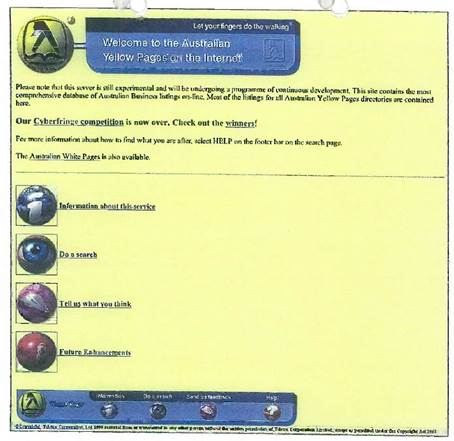
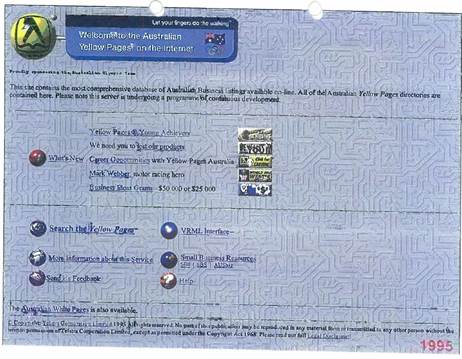
(b) 1996 – Telstra’s website:
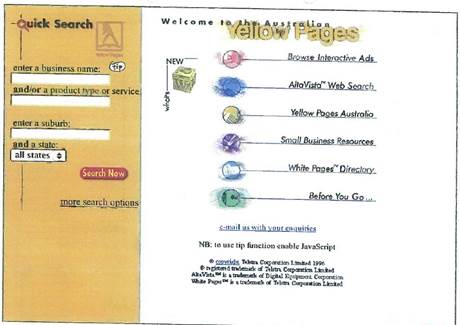
(c) 1998 – Telstra’s website:
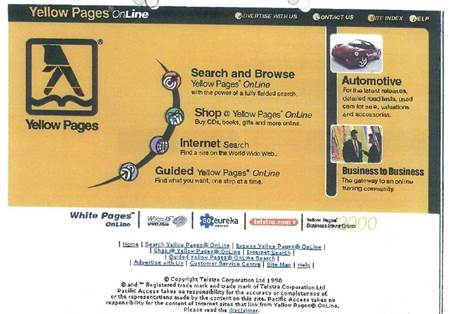
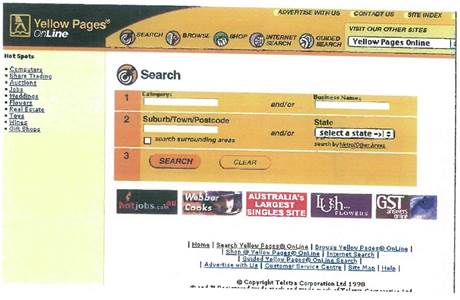
(d) 2004/2005 – both parties’ websites:
(i) Telstra:
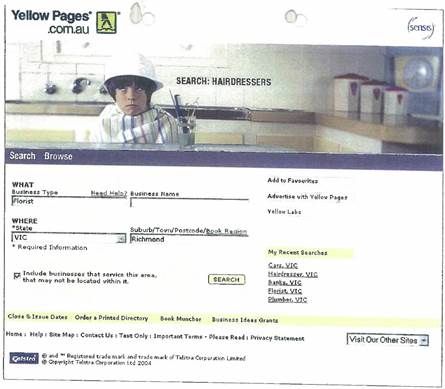
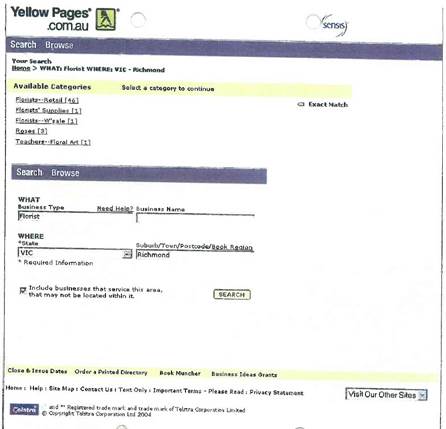
(ii) PDC Respondents:
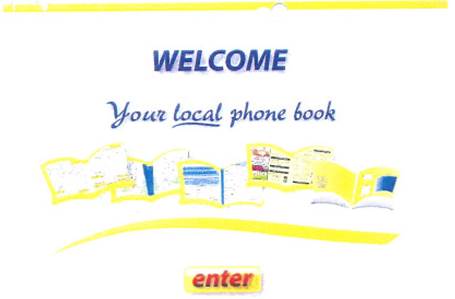
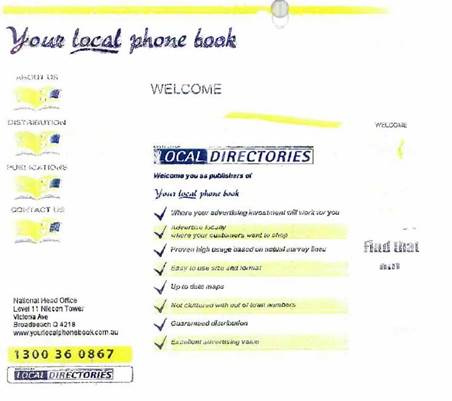
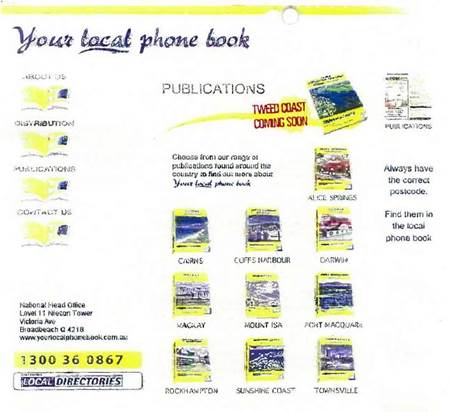
(e) 2006 – both parties’ websites:
(i) Telstra:
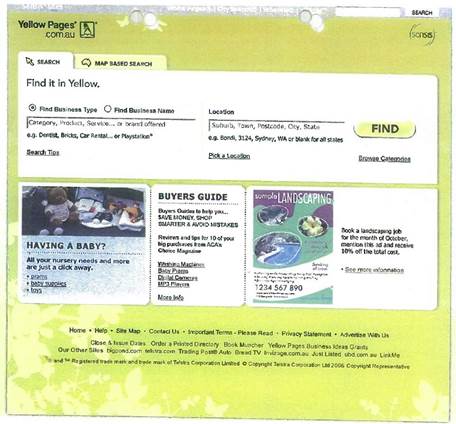
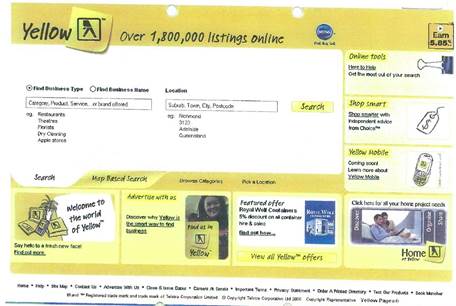
(ii) PDC Respondents:
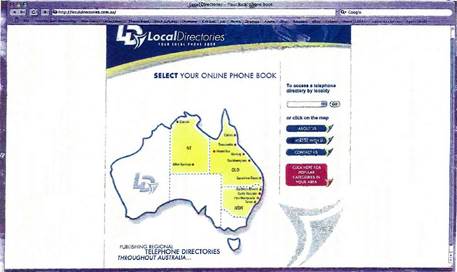
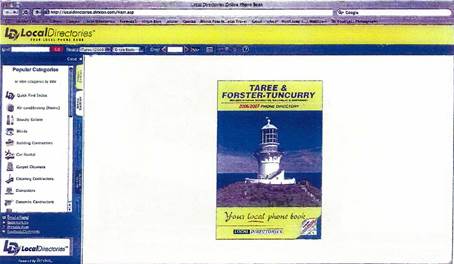
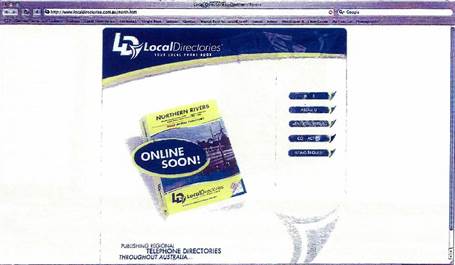
(f) 2008 – both parties’ websites:
(i) Telstra:
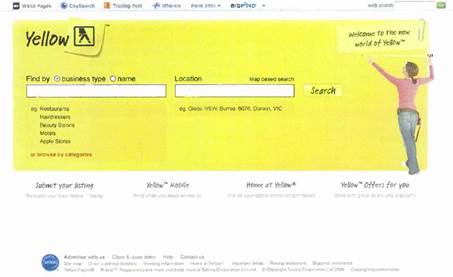
(ii) PDC Respondents:
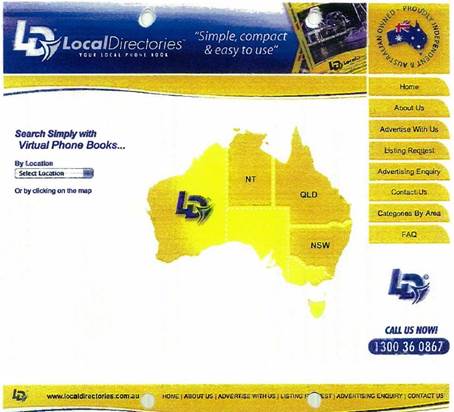
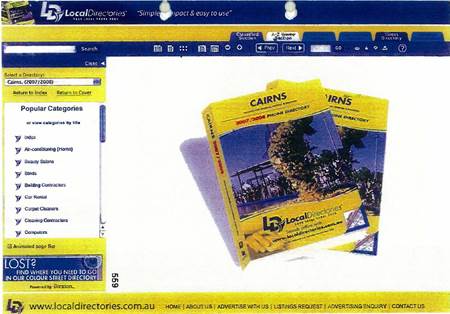
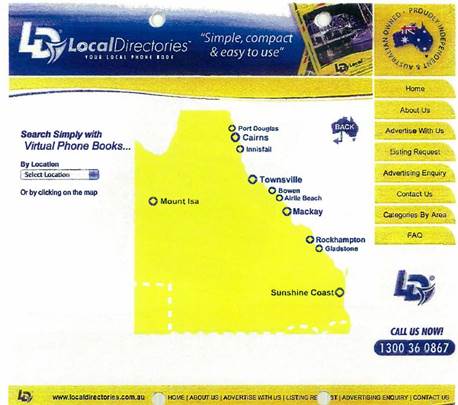
(g) 2010 – both parties’ websites:
(i) Telstra:
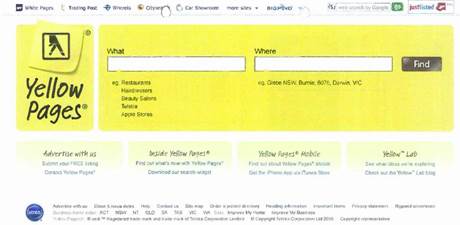
(ii) PDC Respondents – 2009/2010:
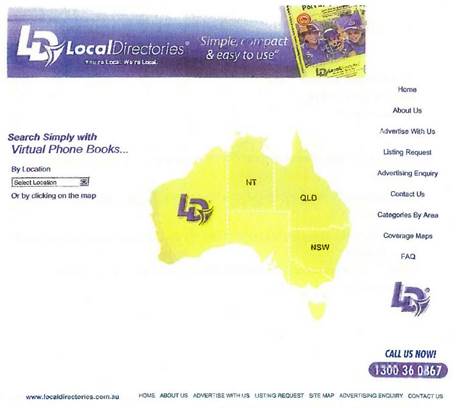
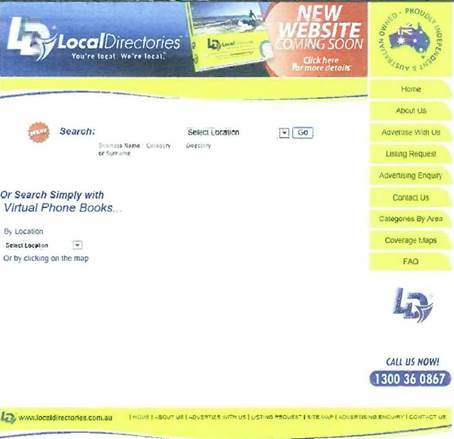
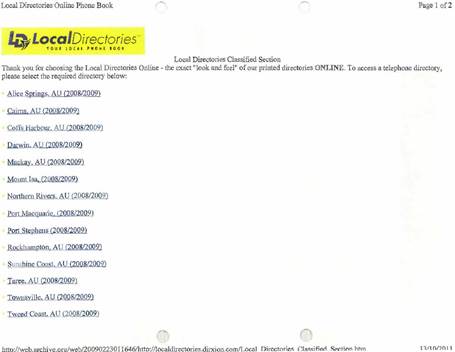
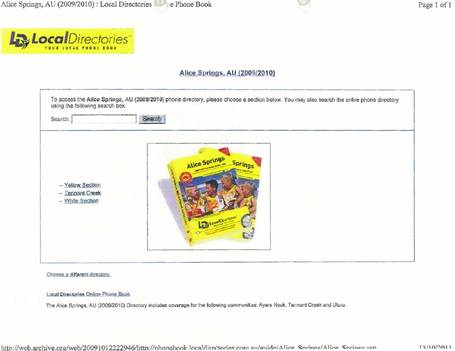
17 I also set out below images of Telstra’s mobile app directory in 2011 and images of the PDC Respondents’ mobile app directory in the same year:
(a) Telstra:
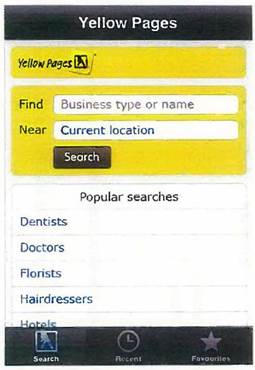

(b) PDC Respondents:
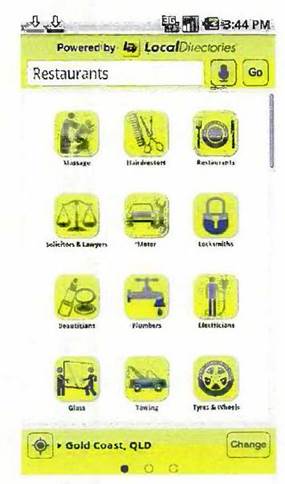
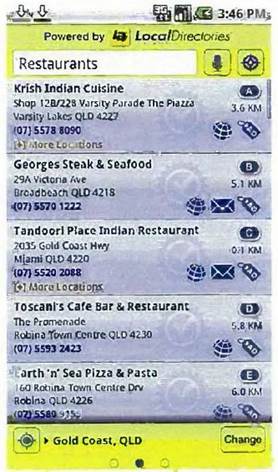
18 In my view it is unlikely that directory users located and used the PDC Respondents’ website or mobile app directories because of their use of yellow.
19 I say this in relation to the PDC Respondents’ mobile app, first, because a directory user has to download the app from iTunes or the equivalent Android online store to their smart phone or tablet. Unlike the respondents’ print directories which were directly delivered to users without any request for the directory, downloading an app required a user to decide that he or she wanted the app. There is no evidence that such choices were informed by the colour yellow. Telstra put on no evidence as to the information provided about the respondents’ mobile app at the Apple or Android on-line stores, or whether yellow was used in promoting it. Its evidence related to the yellow screens of the mobile app once downloaded.
20 In relation to the respondents’ website, directory users cannot undertake a search by the colour yellow. If they perform a search using the word ‘yellow” the evidence tends to show that the main search results will be Telstra’s websites. I infer that directory users are likely to search by various methods including:
(a) going directly to the website of the online directory provider that they wish to use and then searching for the desired business by its type or name. If they take this course there is little merit in Telstra’s complaint regarding the respondents’ use of yellow on their website. Any choice to use the respondents’ online directory was made before the yellow colour of the website was apparent to the user;
(b) by using a search engine (such as Google) to locate the directory provider that they wish to use. If they take this course the evidence tends to show that Telstra’s purchase of sponsored links to words such as “phone directories company” and “local directories” means that Telstra websites appear high on the results page. Even leaving those matters aside it is again difficult to see any merit in Telstra’s complaint regarding the respondents’ use of yellow. Any choice to use the respondents’ online directory is again made before the yellow colour of their website is apparent to the user; or
(c) by using a search engine to locate the desired business by type of business or by its name. If they take this course then various search results will appear on the results page. A directory user’s choice between them is unlikely to be because of the yellow colour of the respondents’ website because it is not apparent at that point.
21 Telstra’s case largely turns on the proposition that a directory user who chooses or who happens upon the PDC Respondents’ yellow coloured website (or its mobile app directory once downloaded) would be left with the impression that it was Telstra’s service, and that the user would commence using it because of Telstra’s reputation and then may continue to use it on later occasions having been enticed into the respondents’ web. Telstra argues that the respondents did not do enough to distinguish their yellow coloured website and mobile app, under the (it says) non-distinctive Local Directories name, from Telstra’s services.
22 I do not agree. As I explained at [105]-[120] of the earlier reasons, by June 2005 (from which date Telstra seeks to impugn the PDC Respondents’ use of yellow on their directories) the use of yellow in respect of business directories in Australia was widespread. The respondents had extensively used yellow in their print directories and marketing for a decade before Telstra raised any objection. Also, as I said at [121]-[129], yellow pages and covers were commonly used on print directories around the world. To an extent yellow had become a standard colour for business directories (as I explained at [440]-[454] and [468]-[470]). As a result many consumers are likely to have seen the respondents’ use of yellow on their website and mobile app just as signifying it as a directory, or as part of the respondents’ branding, rather than as signifying that it was published by or associated with Telstra.
23 I note too that Telstra’s use of yellow on its website varied from 1995 to the present. For example, in 1995 its use of yellow was limited and one of the webpages was almost entirely coloured blue. In 2004/2005 Telstra’s website was largely coloured blue and white, and at the same time the PDC Respondents’ website featured yellow. While Telstra’s use of yellow increased over time its use was inconsistent. This is likely to have caused many directory users (if they were concerned at all about the source of the respondents’ website and mobile app directories) to place less significance on the colour yellow, viewed in isolation, as signifying that the directory was associated with Telstra. In my view online and mobile app directory users are more likely to be concerned with the functionality than branding.
24 Further, as I now explain, I consider that the PDC Respondents sufficiently differentiated their website and mobile app directories from Telstra’s corresponding services. As I explained at [580]-[589] of the earlier reasons, the respondents were not required to do much to distinguish their online and mobile app directories.
25 The first important point of differentiation is Telstra’s use of its well-recognised Yellow Pages Trade Mark with the Walking Fingers on its online and mobile app directories. For all practical purposes Telstra’s use of yellow on its directories was always in association with a prominent Yellow Pages Trade Mark including the Walking Fingers (except for between 2006 and 2009 when it used the Yellow Trade Mark including the Walking Fingers). Given that a Yellow Pages Trade Mark was always used, in the absence of the trade mark on the respondents’ directories it is hard to see a directory user suffering from the misconception that it was associated with Telstra.
26 Secondly, the PDC Respondents’ prominently used the LD Name and Logo on their website from 2006, and on their mobile app directory from 2011. As I said at [595] of the earlier reasons, while the words “Local Directories” may be seen as descriptive I consider the LD Name and Logo is distinctive. It assists in differentiating the respondents’ services from Telstra’s.
27 Thirdly, the respondents’ online directory had a greater local focus than Telstra’s corresponding services. From 2006 their website depicted a map of Australia and set out the geographical regions covered by PDC directories in three states. Amongst other things, the website asked users to search for businesses by first selecting the applicable region from the map. If this was done an image of the print PDC directory for the selected region was displayed. This informed directory users that the coverage of the PDC online directory was limited to certain regions. The domain name itself and other statements such as the tagline “Your local phone book” emphasised that it had a local focus. Telstra’s online directory was national in its coverage. Although it was possible to search by region or by reference to businesses in the area around the user, it was less local in its focus. The consumer survey evidence indicates that a local focus was important to directory users.
28 Fourthly, from 2007 the PDC website referred back to the print PDC directories on the top of each webpage with the words “simple, compact and easy to use”, which pointed to the difference between the print PDC directories and Telstra’s larger, more cumbersome, co-bound White Pages/Yellow Pages print directories. From 2006 it contained prominent images of the print PDC directories which, as I explained in the earlier reasons, were quite different to Telstra’s co-bound print directories. This too strongly indicated to directory users that the respondents’ website was not published by or associated with Telstra.
29 Taking these points of difference together the respondents did enough to differentiate their online and mobile app directories from Telstra’s rival services. I do not accept that the PDC Respondents’ conduct in publishing their yellow coloured website and mobile app directories under the LD Name and Logo conveyed the representation or imparted the impression to the hypothetical ordinary or reasonable directory user (or a “not insignificant” proportion of the class of directory users) that they were published by or associated with Telstra or its directories in any way.
30 For the reasons I earlier provided, supplemented by the matters I have now set out, Telstra’s claims must be dismissed.
|
I certify that the preceding thirty (30) numbered paragraphs are a true copy of the Reasons for Judgment herein of the Honourable Justice Murphy. |
Associate:




